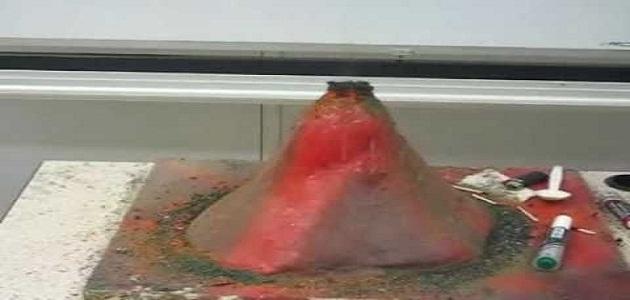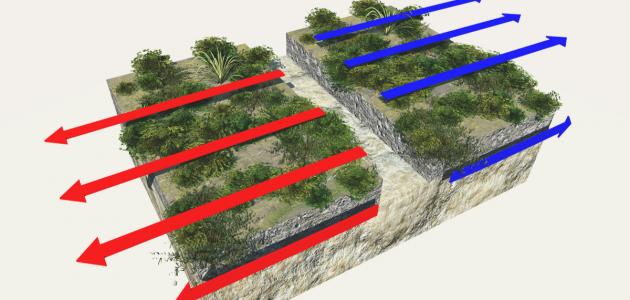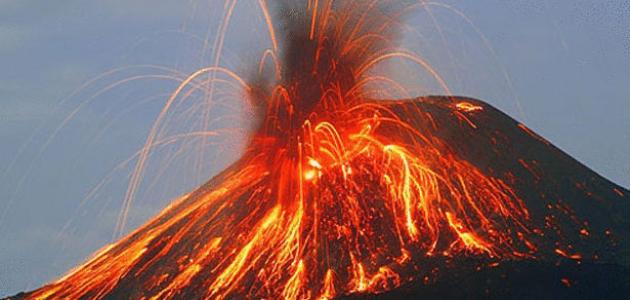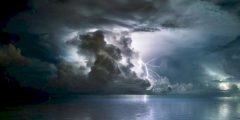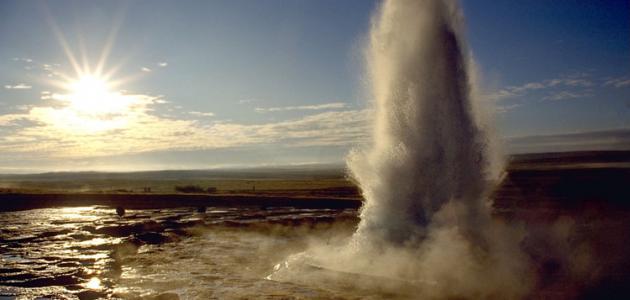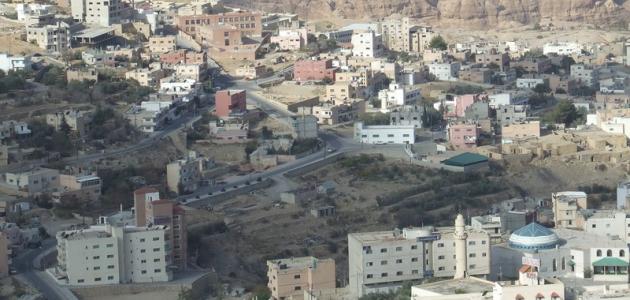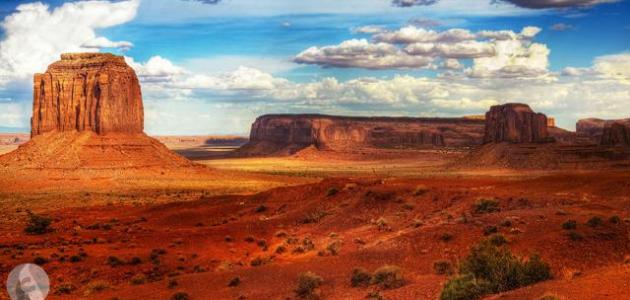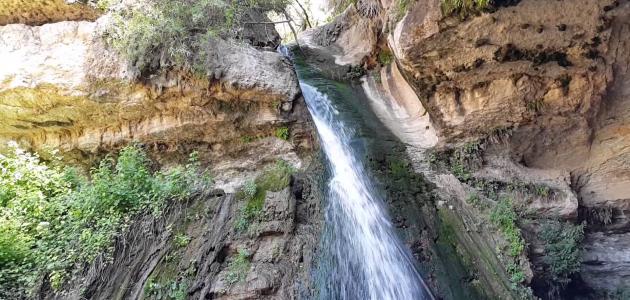How to make a volcano model
Volcanoes are known as openings on the Earth's surface from which hot rocks, fumes, and ash emit, and it is important to teach children how volcanoes occur; To help them understand how it is formed, the reasons for its eruption, and the amazing force responsible for its formation, from this standpoint a model of the volcano can be built that simulates this huge geological formation, and designing a model of the volcano at home is an exciting and amazing experience for them, and this experience is very simple and requires basic materials It is found in all homes, and it should be noted that a model of the volcano can be made in several different ways, and some of them are explained below:
Paper use
A good model of the volcano can be built based on some basic principles of the chemistry of acids and bases, as when acids meet bases, chemical reactions are produced that are somewhat similar to the process of volcanic eruption, and the following is an explanation of this method:
materials needed
The following are the materials needed to make the model of the volcano and the flowing material, which are as follows:
- To make the body of the volcano: At least one sheet of paper, cardboard cut into strips, one sheet of square paper, tape, an empty 550-gram plastic bottle, some flour, two cups of water, suitable paint colors (red, orange, brown, and green), and funnel, and acrylic paint (Acrylic paint) is waterproof and can be dispensed with.
- To make the flux: A cup of vinegar, two tablespoons of baking soda, one squirt of dishwashing liquid, and food coloring.
The method of work
The following steps represent how to create a model of the volcano and its eruption:
Read also:The largest volcano in the world- Start by building a base for the volcano, where a square piece of cardboard is placed, then a plastic bottle is placed in the middle of it, and fixed over it using adhesive tape.
- Glue thin strips of cardboard around the flask to create a cone-like shape.
- Prepare the paper mache by mixing an appropriate amount of flour with two cups of water, taking into account the possibility of adding flour if necessary, then cutting the paper into strips, and dipping each strip in the dough mixture, with the need to emphasize Getting rid of excess water by squeezing it out of the dough mixture.
- Start by sticking the paper mixed with the dough on the cone, and continue to repeat this step until the conical shape is complete, after which the model is left overnight; until dry.
- Painting the volcano in realistic colors such as red, orange, brown, and some green at its base. After completing the paint, the model is left overnight; until it dries, and it should be noted that it is possible to make a reusable model and repeat the experiment many times by coating the model with a layer of waterproof acrylic paint, and leaving it for several hours; to dry.
- Choose a suitable place to apply the experiment, as it is necessary to choose a place that is easy to clean, such as the garden, outside the house, or a large table on which there is no carpet.
- Prepare the volcano mixture by mixing one cup of vinegar with one squirt of dishwashing liquid.
- Add the amount of baking soda and drops of food coloring to the plastic bottle by using the funnel.
- The vinegar mixture with dishwashing liquid is poured into the plastic flask, then the resulting reaction similar to a volcano eruption can be seen, and the moment of application of the experiment can be documented by preparing the camera before starting the experiment.
Putty use
A model of the volcano can be made using homemade putty, by following these steps:
Read also:What are the highest degrees on the Richter scale for earthquakes?materials needed
The following are the materials needed to make the paste used to make the volcano, the method of making the model of the volcano, and the material for the flow:
- To make putty indoors: 6 cups of flour, 2 cups of water, 4 tablespoons of vegetable oil, 2 cups of salt, and food coloring.
- To make the body of the volcano: A protective surface that represents the base of the model. Wax paper can be used, or a thick layer of newspaper, or a wooden box, or a tray covered with tin foil, in addition to the bottom half of an empty plastic water bottle or a tin can .
- To make the flux: XNUMX/XNUMX cup baking soda, XNUMX/XNUMX cup vinegar, XNUMX tablespoon dishwashing liquid, and a few drops of red food coloring.
The method of work
Here are the steps to make a volcano model using homemade putty:
- First, a suitable bowl is chosen to mix the paste materials with each other, taking care to sift the flour in advance before starting work with it or break up large pieces, if any, using a fork, then pour salt, flour, and oil into the bowl; in order to mix them together.
- Put the water in a large bowl with the addition of 2-3 drops of food coloring to it, as this step will help distribute the color evenly on the model, which means that the entire volcano will take on a consistent color, but it is possible to dispense with the addition of food coloring and use water directly for kneading.
- Mixing the ingredients with each other and kneading them with hands, until a large and consistent sponge ball is formed from the dough, and attention must be paid to the texture of the paste, so it must be wet and allow it to be formed, so if it is dry, a tablespoon or more of water must be added, while if it contains a lot of water, you must add an amount of flour.
- Leave the paste after completing the kneading for a period ranging between 1-2 hours before starting to form it, and you must also make sure before starting to use it that it is sufficiently moist, and if it is dry, an amount of water must be added.
- Start forming the volcano model by placing the protective surface that represents the base, then placing half of the plastic bottle in the middle of the base and fixing it with one hand, and using the other hand to spread the paste along the bottle, starting from the bottom to the top, passing through all its sides; To tighten its adhesion to the base, while trying to extend the paste in a lumpy and uneven manner, that is, it contains zigzags; Because volcanoes rarely take the shape of a perfect cone.
- Leave the volcano model for 24 hours; In order for it to dry, it can be dried faster by placing it inside the oven for about an hour at a temperature equal to 107°C, after which the volcano can be painted with suitable colors if food coloring is not used in preparing the paste.
- Put half a cup of baking soda in a plastic vial, then, using the same standard, put vinegar and drops of red food coloring, with the addition of a tablespoon of dishwashing liquid; To add a bubble effect, mix the ingredients together.
- Adding the vinegar mixture with other materials to the plastic bottle, as this will lead to a reaction similar to the eruption of a volcano.
The mechanism of action of the volcano model
Making a volcano model based on the interaction between baking soda and vinegar is a traditional science project, and it is equivalent to the work of a real volcano, but using household and non-toxic materials. Soda can, as carbon dioxide gas is used in the carbonation process when producing soft drinks, and when the can is shaken, the gas becomes disturbed, and since it is confined and there is not enough space in the can, it will spread out very quickly when opened, and this is similar to what happens when the volcano erupts.
Read also:Where are volcanoes located?A method for simulating volcanic formation
Volcanoes erupt when the rocks of the earth's crust are broken, and hot magma erupts from the mantle layer, which leads to its flow to the areas surrounding the volcano on the earth's crust, and after it cools it hardens and forms lava. Simulating this process, wax, water and sand can be used, so that the wax represents the hot magma, the sand represents the rocks of the earth's crust, while the water represents the areas surrounding the volcano on the earth's crust, within the following experiment:
materials needed
Materials needed for the experiment: a 400 ml glass flask, red or orange wax, some sand well washed with water, water, an alcohol burner or alcohol lamp, matches, and a stand for the flask.
Safety Instructions
Among the instructions to be followed when doing the experiment:
- Wear protective glasses while doing the experiment.
- Use a high-quality glass cup that can withstand high temperatures, or use a cup for measuring liquids.
- Do not place the glass beaker directly above the stove.
The method of work
Here are the steps to simulate volcano formation:
- First, light the candle wick for up to 20 seconds, then carefully tilt the candle over the beaker; To drip the melted wax inside it, while continuing this process to get approximately 2-3 teaspoons of wax in the beaker, then the candle is extinguished.
- Leave the melted wax until it hardens and hardens, after which a thin layer of sand is placed to cover the wax, about 2.5 cm thick.
- Carefully fill the beaker with water; so that the water does not become cloudy, with an emphasis on waiting for about 30 seconds before starting the experiment; Until the sand settles and the water clears.
- Ignite the alcoholic lamp using sulfur sticks, and it is indicated that if the alcoholic burner is used, faster results can be obtained, and first it is taken into account to wait for a minute; Until the flame of the burner is stable, and then the beaker holder is placed over the alcoholic lamp, and the beaker is placed on top of it.
- heat the beaker over low heat; To get a better result, when the wax melts, a faint whistling sound will be issued with the appearance of a spherical protrusion in the sand layer, and this indicates the rise of the hot wax (magma) from the bottom, passing through the sand layer (the earth’s crust), then the water (the areas surrounding the volcano on the earth’s crust). In the end, the spherical shape will explode in the upper part of the beaker, and when it explodes, and with the passage of time, the wax will solidify and become coherent, and this indicates lava, and it must be noted that the type of reaction produced depends on the thickness of the layer of wax and sand, as well as the strength of the heating, with the need to emphasize Keep the stove temperature as constant as possible.
